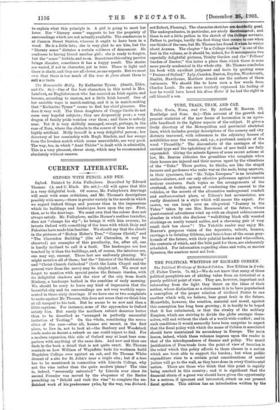C URRENT LITERATURE.
OXFORD WITH PENCIL AND PEN.
Oxford. Painted by John Fulleylove. Described by Edward Thomas. (A. and C. Black. 20s. net.)—All will agree that this is a very delightful book. Of course, Mr. Fulleylove's drawings will meet with some criticisms, and Mr. Thomas's descriptions possibly with more,—there is greater variety in the moods in which we regard Oxford things and persons than in the impressions which its buildings and landscapes have upon the eye. First, then, as to the drawings. We must own that the colour does not always satisfy. Mr. Fulleylove, unlike Horace's restless traveller, does not "change his sky" ; he brings it with him oversee; he invests Oxford with something of the hues with which Italy and Palestine have made him familiar. We should say that the clouds in the pictures of "Bishop Heber's Tree," "Corpus Christi," and "The Clarendon Building" (the old Clarendon, it may be observed) are examples of this peculiarity, for, after all, one is hardly inclined to call it a fault. The landscapes are less touched by it than the buildings, and, of course, the interiors are, one may say, exempt. These last are uniformly pleasing. Wo might mention all of them; but the " Interior of the Sheldonian" and "Christ Church Cathedral" (both the Latin Chapel and the general view from the nave) may be singled out. We must not forget to mention with special praise the Botanic Garden, with its delightful shadows and the view of the city from South Hinksey, a landscape bathed in the sunshine of early morning. We should be sorry to leave any kind of impression that the beautiful city and its surroundings are not very worthily repre- sented in these sixty drawings. If we have one or two complaints to make against Mr. Thomas, this does not mean that we think him at all unequal to his task. But he seems to us now and then a little captious. For instance, none of the approaches to Oxford satisfy him. But surely the northern suburb deserves better than to be described as "arranged in perfectly successful imitation of Tooting." On the whole, considering the neces- sities of the case—after all, houses are meant, in the first place, to live in, not to look at—the Banbury and Woodstock roads make as decent a suburb as one could expect to find. For a modern expansion, this side of Oxford may at least bear com- parison with anything of the same date. And now and then one finds in the book a detail that is not quite exact. Mr. Thomas reminds us how William of Waynflete bade his workmen build Magdalen College over against an oak, and Sir Thomas White dreamt of a site for St. John's near a triple elm ; but if a tree has to be mentioned in connection with Lincoln College, why not the vine rather than the quite modern 'plane ? The vine is, indeed, " reverently entreated " by Lincoln ever since its second. Founder was moved by the eloquence of the Rector preaching on "Behold and visit the vine" to complete the un- finished work of his predecessor (who, by the way, was Richard. not Robert, Fleming). The character sketches are decidedly good. The undergraduates, in particular, are nicely discriminated; and there is not a little pathos in the sketch of the College servants. Pathos is, perhaps, hardly the first thing that occurs to one when one thinks of the race, but Mr. Thomas has found it when he writes about Acamas. The chapter " In a College Garden" is one of the best in the volume, as it should be, indeed, for it accompanies two especially delightful pictures, Trinity Garden and the " Fellows' Garden of Exeter," this latter a place than which there is none more purely academical in the whole city. Mr. Thomas concludes his book with excellent judgment and taste by quoting some " Praises of Oxford." Lyly, Camden, Burton, Dryden, Wordsworth, Hazlitt, Hawthorne, Matthew Arnold are the authors of these testimonia. We should like to have seen a few words from Charles Lamb. No one more tenderly expressed his feeling of how he would have loved his Alma Mater if he had the right to call himself a son.






































 Previous page
Previous page